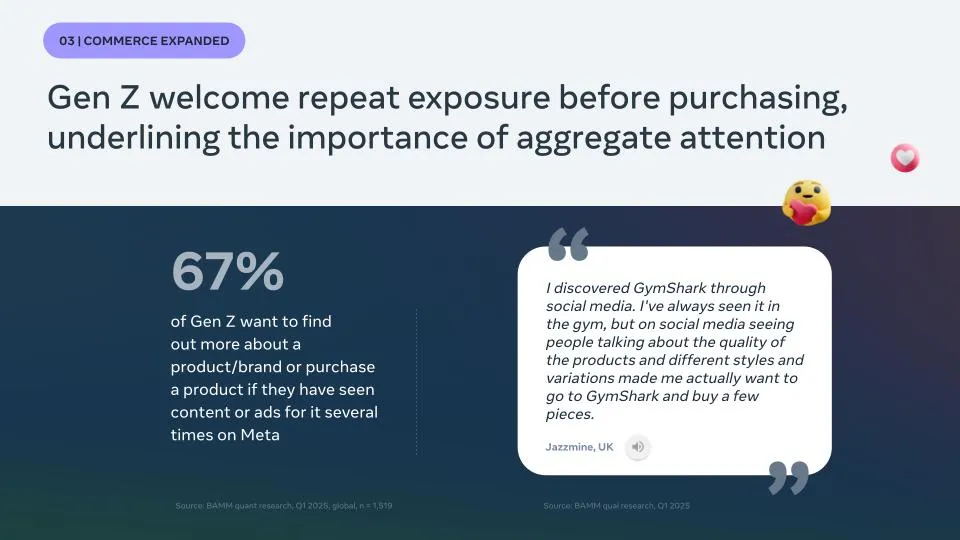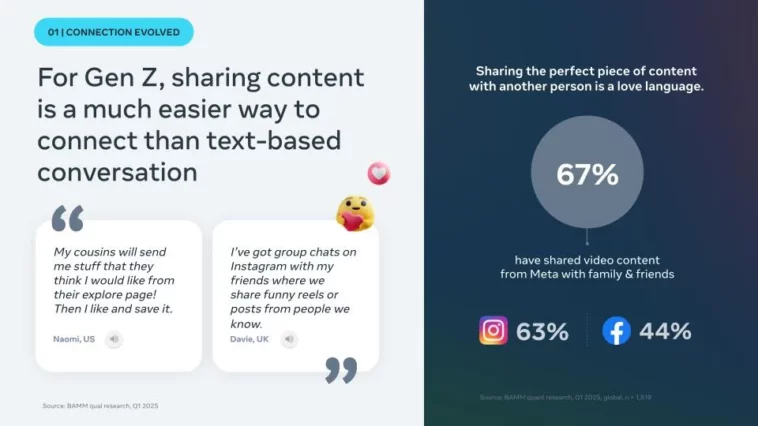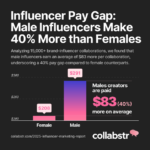As the largest and most digitally native generation in history, Gen Z is not just reshaping how we communicate—they’re redefining how brands must engage to stay relevant. Insights from Meta and BAMM Global, drawn from an extensive study of 18- to 24-year-olds across Brazil, Germany, Japan, the UK, and the US, paint a vivid picture of a generation that blurs the lines between connection, culture, and commerce in entirely new ways.
For Gen Z, content is far more than entertainment—it’s emotional currency. Meta found that 67% of Instagram and Facebook users in this age group share video content with family and friends. Sharing isn’t just about broadcasting; it’s a personal gesture akin to saying, “I saw this and thought of you.” This dynamic has transformed content into a love language, with videos and memes serving as subtle emotional expressions and conversation starters.
The implications for marketers are profound. Gen Z doesn’t want to be sold to—they want to feel seen. Crafting joyful, helpful, and share-worthy content is essential to becoming part of their inner dialogue. Brands that prioritize intimacy—featuring real people, direct eye contact, or one-to-one storytelling—are more likely to break through. Meta-backed data even shows ads that highlight human presence achieve 81% higher effectiveness.
Gone are the days of mass appeal. Gen Z thrives in a world of micro-cultures, personal passions, and hyper-specific content. They actively curate their social feeds, seeking relevance over reach. According to Meta’s research, 63% of Gen Z users fine-tune their Instagram or Facebook feeds to align with their interests, ensuring their time online feels purposeful.
This generation’s relationship with short-form video (SFV) is particularly striking. Whether it’s workout tips, self-improvement hacks, or financial advice, Gen Z treats platforms like Instagram as a kind of visual search engine for life. A staggering 81% say they use the app for self-development. They’re not waiting for content—they’re training algorithms to bring the right ideas to them.
For brands, that means ditching the one-size-fits-all campaign in favor of modular creativity. Think diverse messaging across formats like Reels, Stories, and Feed. Use micro-creators and niche experts to tell authentic stories that resonate. And don’t worry about whether Gen Z follows these creators—71% are open to discovering content from voices they don’t yet know.
For Gen Z, shopping is no longer a separate task—it’s woven into their social experiences. Discovery is ongoing, passive, and welcome. As they scroll, laugh, and learn, they’re also saving products, bookmarking gift ideas, and entering purchase funnels without realizing it. According to Meta, 78% say they’re most likely to discover new brands via video, and 73% believe content curation leads to more relevant advertising.
The classic sales funnel is obsolete. Gen Z may not be “in-market” now, but they’re always in “consideration mode.” A well-placed video or creator recommendation can move them toward purchase—even if it’s just a product saved for later. Repeated exposure matters too: 67% say they’re more inclined to buy from brands they’ve seen multiple times.

This evolving behavior calls for a new kind of marketing frequency—one that prioritizes consistent, multi-platform engagement. Meta’s analysis suggests that frequency optimization can improve effectiveness by up to 15%. Pair that with fast customer service (even AI-driven), and brands can meet Gen Z’s expectations for speed and convenience.
To win with Gen Z, brands must build a fluid strategy that adapts across platforms, formats, and creators. Authenticity, utility, and emotional resonance are no longer optional—they’re essential. Whether it’s a video meme that sparks laughter or a creator explaining a product’s benefits in-depth, relevance is the new currency.
Ultimately, marketers must abandon rigid, centralized messaging and embrace an ecosystem of ideas—diverse in voice, flexible in form, and tailored to the ever-shifting pulse of Gen Z. Connection, culture, and commerce are no longer separate strategies. For Gen Z, they are one and the same.







Comments
Loading…